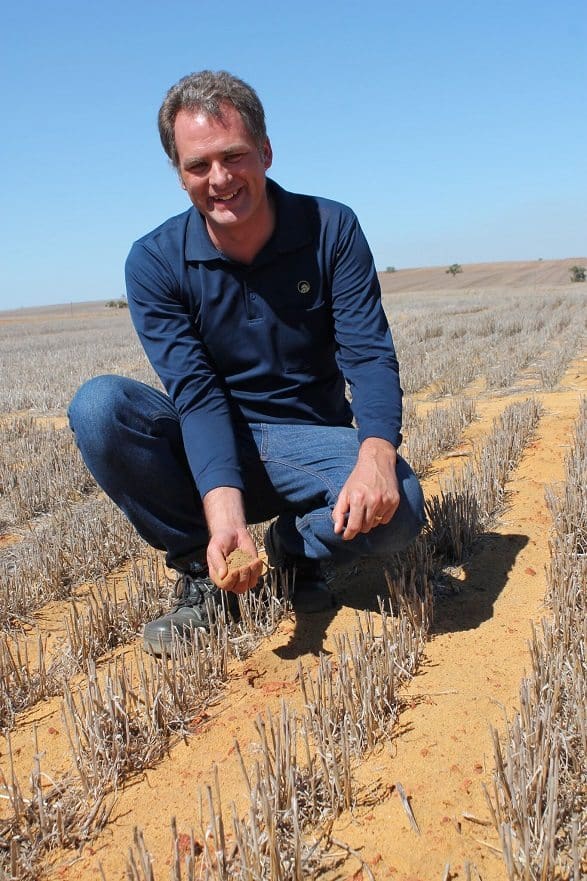Key points:
- Burying water repellent topsoil can reduce repellence by an average of 70 per cent compared to untreated topsoil
- Growers need strategies for crop nutrition after using soil inversion, as soil profile changes are persistent.
RESEARCH into whether the practice of inverting water repellent topsoil is just burying a long-term problem has in fact given this strategy the ‘green light’ for its use on Western Australian grain farms.
One-off strategic inversion of sandplain soils has been undertaken by many of the State’s growers since 2007 as a means of removing water repellent topsoils and burying the soil beneath the ground to create a new, wettable soil surface.
The Grains Research and Development Corporation (GRDC)-supported research ‘What is the fate of buried water repellent topsoil?’ aimed to answer the questions of whether the repellent topsoil stayed repellent after burial, and how quickly the subsoil that was brought up to the soil surface became repellent.
Researchers at the Department of Primary Industries and Regional Development (DPIRD) found:
- The repellence of inverted (buried) water repellent topsoil was reduced by 70 per cent on average, compared to adjacent surface topsoil that had otherwise been managed identically
- The decline in repellence of severely repellent buried topsoil could be rapid, with a reduction of 79 per cent in one year at one site
- Build-up of surface repellence is slow and is unlikely to exceed low levels within the first 10 years, except in cases of incomplete soil inversion in soils with low clay content.
DPIRD research officer Stephen Davies said the research aimed to resolve concerns that by inverting repellent soils, the problem could persist at deeper levels.
“One of the concerns has been that inversion may result in the formation of a much deeper water repellent layer if the repellence of the buried topsoil did not break down once it was buried, and in the longer term this could potentially make such soils even harder to manage,” Dr Davies said.
“Our findings support the initial hypothesis that microbes will reduce water repellence in the buried topsoil because this layer eventually ‘wets up’ and stays wetter for longer. There were rapid and sustained declines in the repellence of buried topsoil.”
In March 2017, the researchers undertook a series of surveys across 11 commercially managed paddocks in the northern WA grainbelt – in a zone from Mingenew to Meckering – where water repellence ranged from moderate to very severe.
Soil inversion had been undertaken on the sandplain soils as a one-off soil amelioration tactic using commercial scale mouldboard ploughs at all sites. Comparative adjacent areas in the same paddock had been left undisturbed.
The date of soil inversion varied from one to nine years across the sites, enabling comparisons of where topsoil had been buried for varying lengths of time.
Dr Davies said the research showed build-up of surface repellence is unlikely to exceed low levels within the first 10 years.
“The build-up of soil water repellence in inverted subsoils brought to the surface is dependent on many factors including inversion depth, topsoil clay content, net primary productivity and biological activity,” he said.
“Soil fertility measurements also suggest that changes in distribution of organic carbon and nutrients, particularly nitrate and sulphur, are persistent.
“Like repellence, organic carbon is slow to build up in the surface of inverted soils but remains higher in the buried topsoil even after eight or nine years.”
Dr Davies said soil inversion could improve crop growth and grain yield, but strategies for crop nutrition post-inversion would need to account for the increased demand and the change in nutrient distribution down the profile.
He said growers undertaking soil inversion needed to be aware that the changes in the soil profile were substantial and would last more than 10 years.
“This means that water repellence on inverted soils will be ameliorated for the long-term, but organic carbon and some nutrients will remain low in the surface soil for an extended period,” Dr Davies said.
Sources: GRDC, DPIRD
Grain Central: Get our free daily cropping news straight to your inbox – Click here


HAVE YOUR SAY